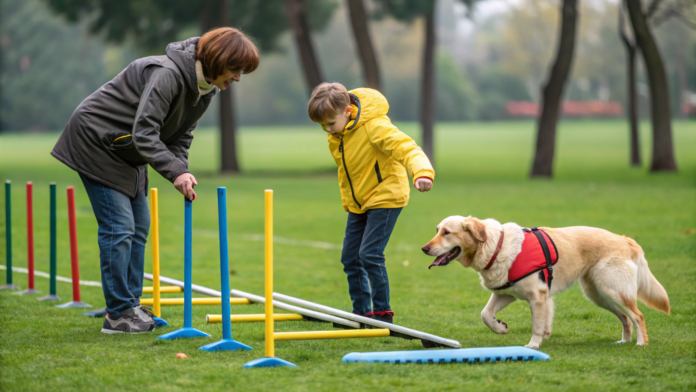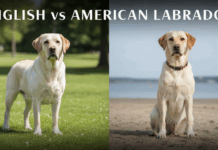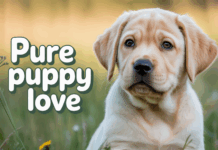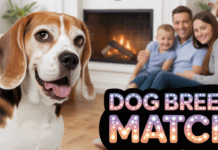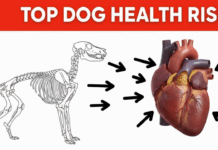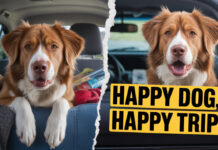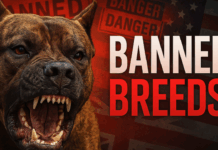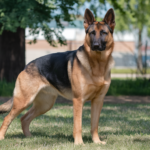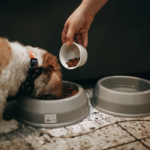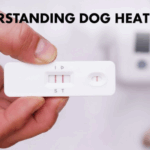Last Updated on February 4, 2025 by Dogs Vets
Dogs are more than pets—they’re partners capable of life-changing roles. Whether it’s aiding individuals with disabilities, comforting hospital patients, or competing in high-energy agility courses, specialized training unlocks your dog’s potential.
This guide dives into service dog training, therapy dog certification, and agility champion preparation, offering actionable steps, expert insights, and answers to common questions. Let’s transform your pup into a confident, skilled teammate!
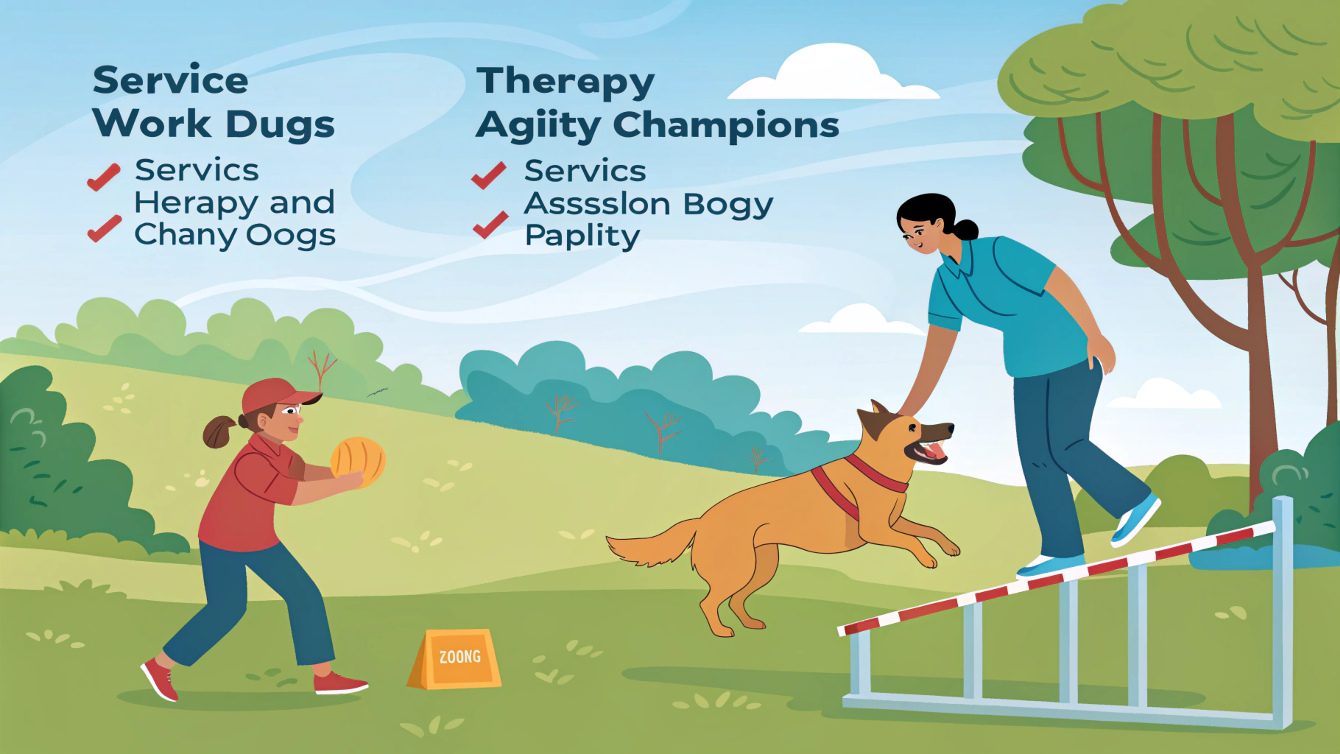
Section 1: Service Dog Training
What Is a Service Dog?
Service dogs are trained to perform tasks that mitigate disabilities, such as guiding the visually impaired, alerting to seizures, or providing mobility support. Under the ADA, they have public access rights.
Key Traits for Service Dogs:
- Calm temperament
- High focus and obedience
- Problem-solving skills
Step-by-Step Training Process
- Basic Obedience Mastery:
- Commands: Sit, Stay, Heel, Leave It, Come.
- Use positive reinforcement (treats, praise) to build reliability.
- Task-Specific Training:
- Example Tasks:
- Retrieving medication.
- Turning lights on/off.
- Deep Pressure Therapy (DPT) for anxiety.
- Customize tasks to the handler’s needs.
- Example Tasks:
- Public Access Training:
- Practice in busy environments (malls, transit).
- Teach ignoring distractions (food, other animals).
- Certification & Legal Rights:
- Note: No official U.S. certification exists, but passing the ADA’s “public access test” is critical.
- Document training logs for credibility.
Challenges & Solutions:
- Overstimulation: Gradually expose dogs to stressors.
- Task Generalization: Train tasks in multiple settings.
Pro Tip: Partner with organizations like Assistance Dogs International (ADI) for structured programs.
Section 2: Therapy Dog Training
What Is a Therapy Dog?
Therapy dogs provide emotional support in hospitals, schools, or nursing homes. Unlike service dogs, they don’t have public access rights unless invited.
Key Traits for Therapy Dogs:
- Friendly and gentle with strangers.
- Comfortable with unpredictable environments.
Step-by-Step Certification Process
- Basic Obedience & Socialization:
- Teach polite greetings (no jumping).
- Expose your dog to medical equipment (wheelchairs, crutches).
- Pass the AKC Canine Good Citizen (CGC) Test:
- Skills: Accepting strangers, walking through crowds, staying calm during handling.
- Therapy Organization Certification:
- Options:
- Requirements:
- Observation of dog-handler teamwork.
- Health screenings (vaccinations, temperament).
- Volunteer Placement:
- Partner with hospitals, libraries, or disaster relief groups.
Challenges & Solutions:
- Burnout: Limit sessions to 1–2 hours.
- Fear of Loud Noises: Desensitize with recordings of alarms or crowds.
Pro Tip: Use a therapy vest to signal your dog’s “working mode” during visits.
Section 3: Agility Training for Competitions
What Is Dog Agility?
Agility dogs race through obstacle courses (tunnels, jumps, weave poles) timed for speed and accuracy. Popular organizations include AKC, USDAA, and UKI.
Key Traits for Agility Dogs:
- High energy and drive.
- Confidence with novel obstacles.
Step-by-Step Training Process
- Build Foundation Skills:
- Focus exercises (eye contact during distractions).
- Directional commands: “Left,” “Right,” “Go On.”
- Introduce Obstacles Slowly:
- Start low: Adjustable jumps, short tunnels.
- Use luring with treats to guide through weave poles.
- Sequencing & Speed:
- Link 2–3 obstacles into short courses.
- Reward faster performances with toys or play.
- Competition Readiness:
- Enter “fun runs” or novice trials for experience.
- Practice in unfamiliar venues to generalize skills.
Challenges & Solutions:
- Bar Knocking: Lower jump heights and rebuild confidence.
- Tunnel Fear: Feed meals near tunnels to create positive associations.
Pro Tip: Film training sessions to analyze handling mistakes.
Section 4: Choosing the Right Role for Your Dog
Assess Your Dog’s Strengths:
- Service Work: Suited for calm, task-driven dogs.
- Therapy Work: Ideal for social, affectionate breeds.
- Agility: Best for high-energy, athletic dogs (Border Collies, Shelties).
Consider Your Lifestyle:
- Service/therapy dogs require ongoing training.
- Agility demands weekly practice and travel to trials.
Mixed Roles? Some dogs can balance agility and therapy work if they have the stamina!
Section 5: Tools & Resources
Training Gear:
- Service Dogs: Mobility harnesses, task-specific tools (light switches).
- Therapy Dogs: Vests, ID badges.
- Agility: Adjustable jumps, tunnels, clickers.
Recommended Books:
- Service Dog Training Guide by Jennifer Hack.
- Agility Right from the Start by Sylvia Trkman.
Online Courses:
- Fenzi Dog Sports Academy (agility).
- Service Dog Training Institute.
5 Frequently Asked Questions (FAQs)
Q1: Can any dog breed become a service dog?
A: Yes, but breeds like Labs, Goldens, and Poodles excel due to temperament and trainability.
Q2: How long does therapy dog certification take?
A: 3–6 months, depending on prior obedience skills and testing schedules.
Q3: Is agility safe for senior dogs?
A: Low-impact courses can work, but consult a vet first. Most competitors retire dogs by age 10.
Q4: What’s the cost of training a service dog?
A: 15,000–30,000 if hiring a pro. Owner-training reduces costs but requires 1–2 years of dedication.
Q5: Can a pet dog transition to a working role?
A: Yes! Start with obedience and gradually introduce role-specific training.
References & Links
- ADA Service Dog Guidelines: ADA.gov
- Therapy Dog Organizations:
- Agility Competitions:
- Books:
- Service Dog Training Guide (Amazon)
- Agility Right from the Start (Clean Run Productions)
Conclusion
Training a dog for service, therapy, or agility work is a journey of patience and partnership. By understanding your dog’s strengths, using positive reinforcement, and tapping into expert resources, you’ll unlock their potential to change lives—or win ribbons!
Call to Action: Share your training milestones in the comments! For more guides, explore our posts on Service Dog Laws and DIY Agility Equipment.
